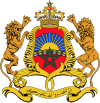List of World Heritage Sites in Morocco
The United Nations Educational, Scientific and Cultural Organization (UNESCO) World Heritage Sites are places of importance to cultural or natural heritage as described in the UNESCO World Heritage Convention, established in 1972.[1] The Kingdom of Morocco accepted the convention on 28 October 1975, making its historical sites eligible for inclusion on the list. As of 2016, nine sites in Morocco are included, all selected for their cultural significance.[2]
Morocco's first site, Medina of Fez, was inscribed on the list at the 5th Session of the World Heritage Committee, held in Paris, France in 1981.[3] Two more sites were added in the 1980s, and another three in the 1990s, followed by two in the 2000s. The latest inscription, Rabat, Modern Capital and Historic City: a Shared Heritage, was added to the list in 2012.[4]
In addition to its World Heritage inscriptions, Morocco also maintains thirteen properties on its tentative list.[5]
World Heritage Sites[]
- Site; named after the World Heritage Committee's official designation[6]
- Location; at city, regional, or provincial level and geocoordinates
- Criteria; as defined by the World Heritage Committee[7]
- Area; in hectares and acres. If available, the size of the buffer zone has been noted as well. A lack of value implies that no data has been published by UNESCO
- Year; during which the site was inscribed to the World Heritage List
- Description; brief information about the site, including reasons for qualifying as an endangered site, if applicable
| Site | Image | Location | Criteria | Area ha (acre) |
Year | Description |
|---|---|---|---|---|---|---|
| Archaeological site of Volubilis | 
|
Fès-Meknès 34°04′26″N 5°33′25″W / 34.07389°N 5.55694°W |
Cultural: (ii)(iii)(iv)(vi) |
42 (100) | 1997 | The important Roman outpost of Volubilis was founded in the 3rd century BCE as the capital of Mauretania, later becoming the capital of the Idrisid dynasty. It contained many buildings, the remains of which have survived extensively to this day.[8] |
| Historic City of Meknes | 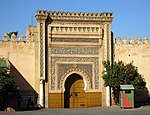
|
Fès-Meknès 33°53′00″N 5°33′30″W / 33.88333°N 5.55833°W |
Cultural: (iv) |
— | 1996 | The former capital of the Alaouite dynasty was founded in the 11th century by the Almoravids and turned into a city with Spanish-Moorish influence during the 17th and 18th centuries.[9] |
| Ksar of Ait-Ben-Haddou | 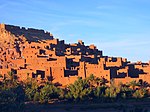
|
Drâa-Tafilalet 31°02′50″N 7°07′44″W / 31.04722°N 7.12889°W |
Cultural: (iv)(v) |
3 (7.4) | 1987 | The Ksar of Ait-Ben-Haddou is an example of a traditional pre-Saharan habitat in southern Morocco, surrounded by high walls and reinforced with corner towers.[10] |
| Medina of Essaouira (formerly Mogador) | 
|
Marrakesh-Safi 31°31′00″N 9°46′10″W / 31.51667°N 9.76944°W |
Cultural: (ii)(iv) |
30 (74) | 2001 | Built during the late 18th century, the fortified seaport of Essaouira has a mix of North African and European architecture, and was a major trading hub between the Sahara and Europe.[11] |
| Medina of Fez | 
|
Fès-Meknès 34°03′40″N 4°58′40″W / 34.06111°N 4.97778°W |
Cultural: (ii)(v) |
280 (690) | 1981 | Fez was founded in the 9th century and reached its apogee as the capital of the Marinid dynasty in the 13th and 14th centuries, from which its urban fabric and major monuments date. It also hosts the world's oldest university, the University of Al Quaraouiyine.[12] |
| Medina of Marrakesh | 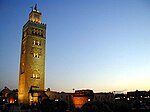
|
Marrakesh-Safi 31°37′53″N 7°59′12″W / 31.63139°N 7.98667°W |
Cultural: (i)(ii)(iv)(v) |
1,107 (2,740) | 1985 | Marrakesh was founded in the 1070s and remained a political, economic, and cultural centre for a long time. Monuments from that period include the Koutoubia Mosque, the kasbah, and the battlements. The city also holds newer features, including palaces and madrasas.[13] |
| Medina of Tétouan (formerly known as Titawin) | 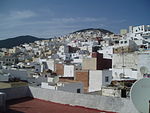
|
Tanger-Tetouan-Al Hoceima 35°34′15″N 5°22′00″W / 35.57083°N 5.36667°W |
Cultural: (ii)(iv)(v) |
7 (17) | 1997 | Morocco's most complete medina at Tétouan served as the main point of contact between Morocco and Andalusia during the 8th century. The town was rebuilt by Andalusian refugees following the Reconquista, the influence of which is evident in its art and architecture.[14] |
| Portuguese City of Mazagan (El Jadida) | 
|
Casablanca-Settat 33°15′24″N 8°30′07″W / 33.25667°N 8.50194°W |
Cultural: (ii)(iv) |
8 (20) | 2004 | The Portuguese fortification of Mazagan, akin to early Renaissance military design from the early 16th century, was taken over by Morocco in 1769. Surviving buildings include the cistern and a Gothic church.[15] |
| Rabat, Modern Capital and Historic City: a Shared Heritage | 
|
Rabat-Salé-Kénitra 34°01′27″N 6°49′22″W / 34.02417°N 6.82278°W |
Cultural: (ii)(iv) |
349 (860) | 2012 | Rebuilt under the direction of the French from 1912 to the 1930s, Rabat blends historic and modern features, such as botanical gardens, the Hassan Tower (not Hassan II Mosque which is built in 1993), and the remnants of Roman, Phoenicians, Moorish and Andalusian settlements from the 12th to the 17th century.[16] |
Tentative list[]
In addition to sites inscribed on the World Heritage List, member states can maintain a list of tentative sites that they may consider for nomination. Nominations for the World Heritage List are only accepted if the site was previously listed on the tentative list.[17] As of 2016, Morocco lists thirteen properties on its tentative list:[5]
| Site | Image | Location | Criteria | Year |
|---|---|---|---|---|
| Grotte de Taforalt (Cave of Taforalt) |

|
Berkane Province, Beni Znassen mountains | Cultural: (v) |
1995 |
| El Gour | 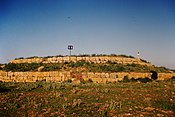
|
Meknès Prefecture | Cultural: (iii) |
1995 |
| Ville de Lixus (City of Lixus) |

|
Larache Province | Cultural: (ii)(iii)(iv) |
1995 |
| Mosquée de Tinmel (Tinmel Mosque) |
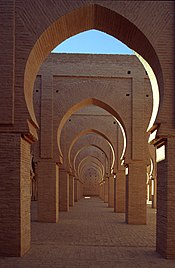
|
Marrakech | Cultural: (ii)(v) |
1995 |
| Taza et la Grande Mosquée (Taza and the Great Mosque) |
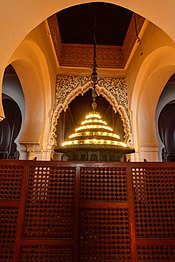
|
Taza Province | Cultural: (ii) |
1995 |
| Moulay Idriss Zerhoun | 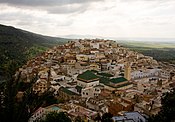
|
Meknès Prefecture | Cultural: (ii)(iv)(vi) |
1995 |
| Parc naturel de Talassemtane (Talassemtane Natural Park) |

|
Chefchaouen Province | Natural: (vii)(x) |
1998 |
| Aire du (Area of the Dragonnier Ajgal) |

|
Tiznit Province | Natural: (vii)(viii)(ix)(x) |
1998 |
| Lagune de Khnifiss (Lagoon of Khenifiss) |

|
Tan-Tan Province | Natural: (vii)(x) |
1998 |
(Dakhla National Park) |
Oued Ed-Dahab Province | Natural: (x) |
1998 | |
| Oasis de Figuig
(Figuig Oasis) |
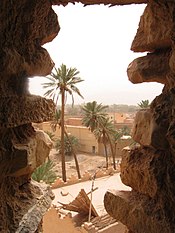
|
Figuig Province | Cultural: (iii)(iv)(v) |
2011 |
| Casablanca, Ville du XXème siècle, carrefour d’influences (Casablanca, Twentieth-Century City, Crossroads of Influences) |

|
Casablanca-Settat | Cultural: (ii)(iv) |
2013 |
| Le chapelet d'oasis de Tighmert, Région présaharienne du Wad Noun (The Chaplet of the Tighmert Oasis, Pre-Saharan Region of Wad Noun) |
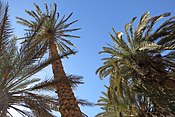
|
Guelmim-Oued Noun | Cultural: (iii)(iv)(v) |
2016 |
See also[]
References[]
- ^ "The World Heritage Convention". UNESCO. Retrieved 21 September 2010.
- ^ "Morocco". UNESCO. Retrieved 9 August 2016.
- ^ "Report of the 5th Session of the Committee". UNESCO. Retrieved 10 August 2016.
- ^ "Decision: 36 COM 8B.18". UNESCO. Retrieved 10 August 2016.
- ^ a b "Tentative List – Morocco". UNESCO. Retrieved 30 September 2016.
- ^ "World Heritage List". UNESCO. Retrieved 28 May 2010.
- ^ "The Criteria for Selection". UNESCO. Retrieved 10 September 2011.
- ^ "Archaeological Site of Volubilis". UNESCO. Retrieved 17 August 2011.
- ^ "Historic City of Meknes". UNESCO. Retrieved 17 August 2011.
- ^ "Ksar of Ait-Ben-Haddou". UNESCO. Retrieved 17 August 2011.
- ^ "Medina of Essaouira (formerly Mogador)". UNESCO. Retrieved 17 August 2011.
- ^ "Medina of Fez". UNESCO. Retrieved 17 August 2011.
- ^ "Medina of Marrakesh". UNESCO. Retrieved 17 August 2011.
- ^ "Medina of Tétouan (formerly known as Titawin)". UNESCO. Retrieved 17 August 2011.
- ^ "Portuguese City of Mazagan (El Jadida)". UNESCO. Retrieved 17 August 2011.
- ^ "Rabat, Modern Capital and Historic City: a Shared Heritage". UNESCO. Retrieved 6 February 2016.
- ^ "Tentative Lists". UNESCO. Retrieved 7 October 2010.
- World Heritage Sites in Morocco
- Lists of World Heritage Sites
- Morocco geography-related lists
- Lists of tourist attractions in Morocco


